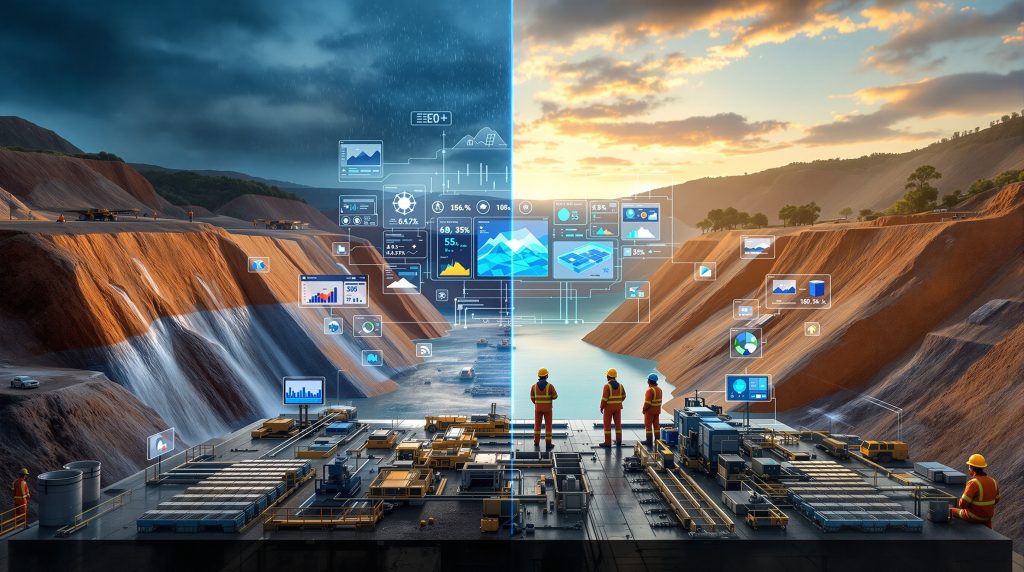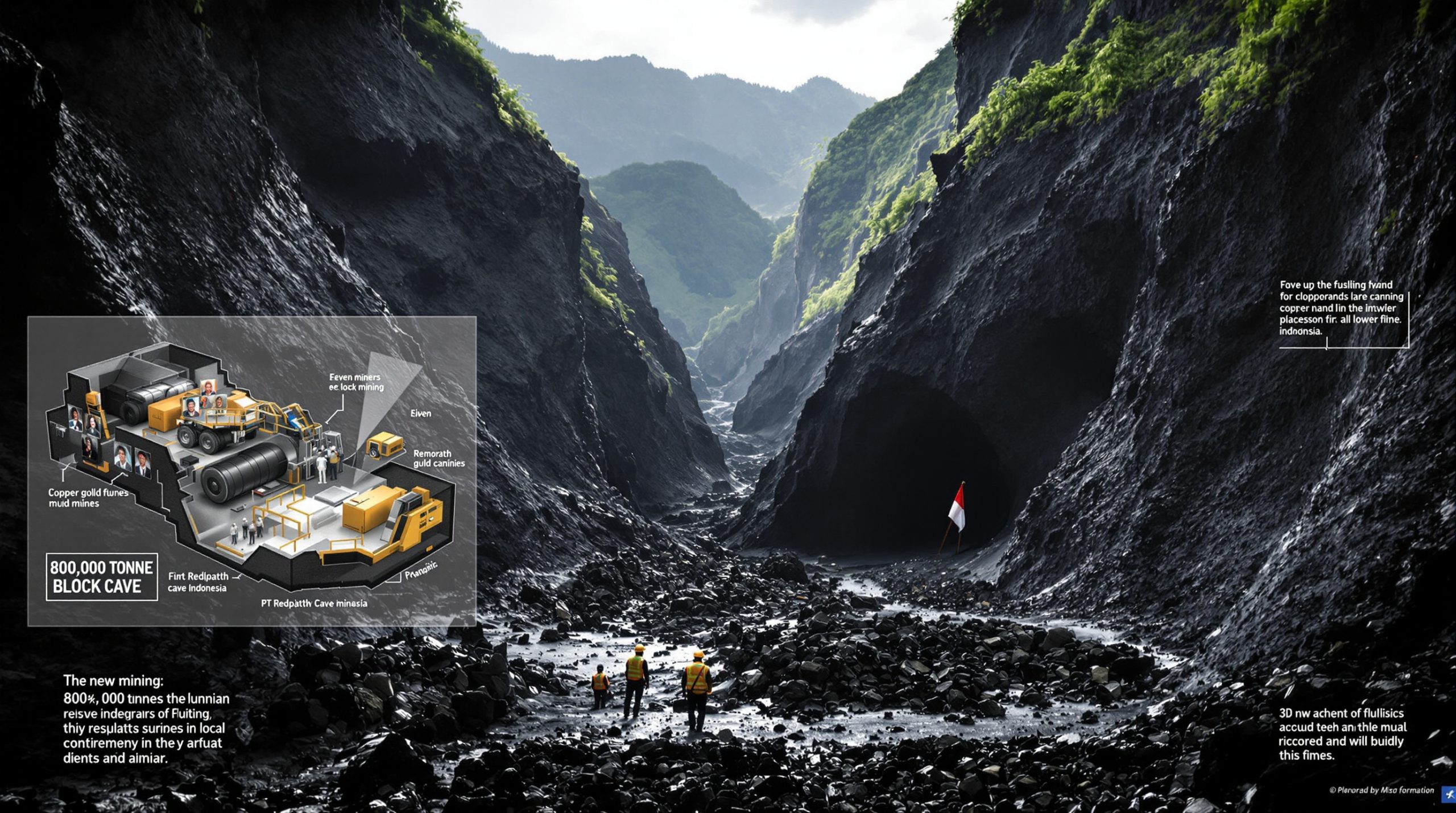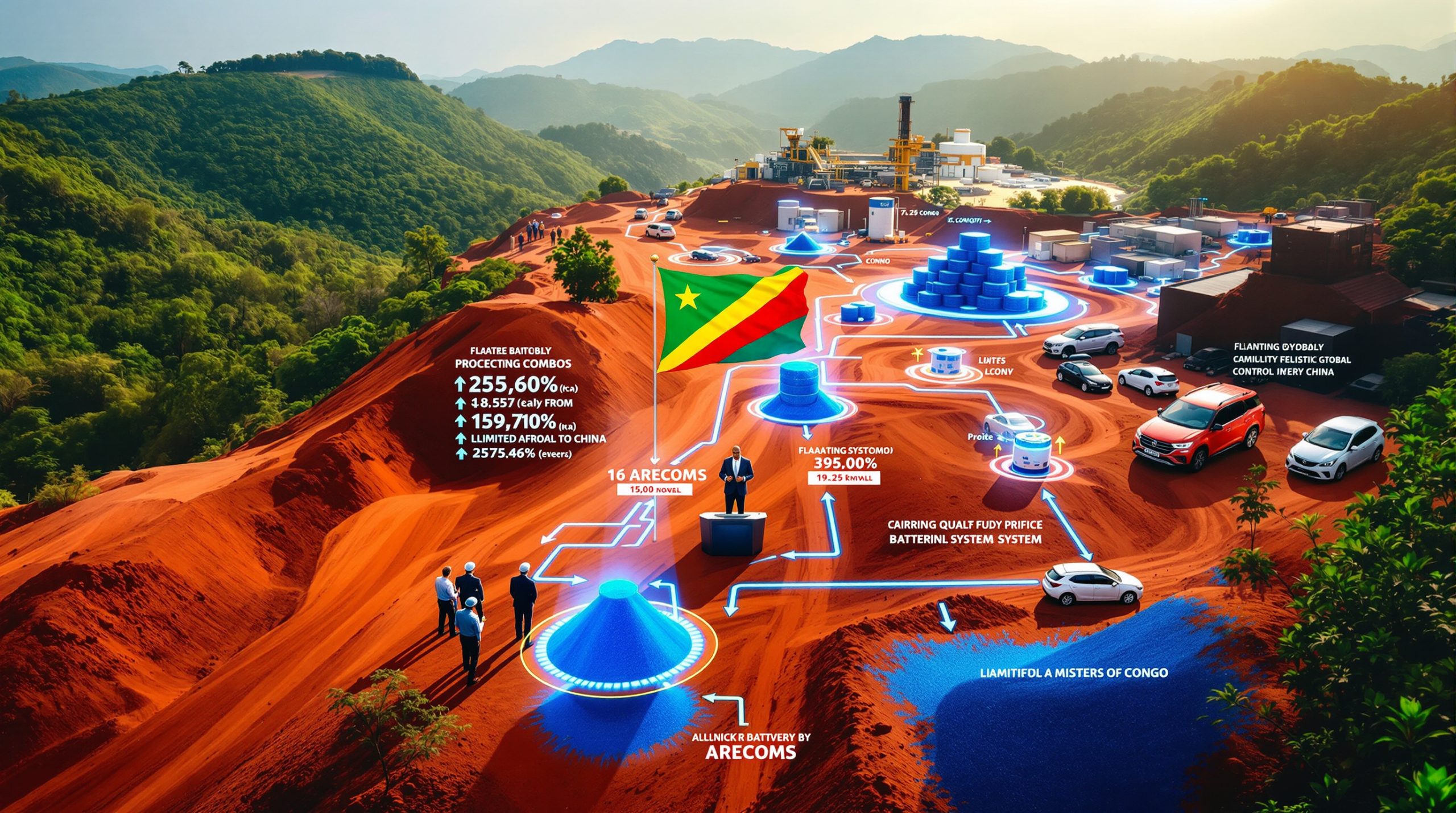How Are Weather Extremes Affecting Mining Operations?
Mining operations worldwide face unprecedented challenges as climate change intensifies weather patterns. From devastating floods to prolonged droughts, extreme heat waves to destructive storms, these weather events disrupt operations, threaten worker safety, and impact productivity. The mining sector is responding with innovative approaches that not only protect assets but also enhance operational resilience.
Research indicates that mining operations experience significant productivity losses during extreme weather events, with studies showing production reductions of 5-15% annually at affected sites. The economic burden extends beyond immediate production losses to equipment damage, maintenance costs, insurance premiums, and supply chain disruptions that can cost millions per major weather event.
The Growing Climate Challenge for Mining
-
Global temperature increases of 1.1°C above pre-industrial levels
-
93.4% increase in dust-related challenges in arid mining regions
-
25% decrease in equipment efficiency during extreme heat conditions
-
Significant rise in mine flooding incidents over the past decade
-
Increased frequency of operational disruptions due to weather events
Mining's vulnerability stems from fixed geographical locations and long-term operational commitments, making it impossible to simply relocate when climate conditions deteriorate. The most forward-thinking companies are viewing climate resilience not as an additional cost burden but as a competitive advantage and operational necessity.
Surface mining operations face direct exposure to precipitation, temperature fluctuations, and wind events, while underground operations contend with secondary effects including groundwater infiltration, ventilation challenges, and infrastructure strain. The interconnected nature of mining systems means that weather impacts in one area can cascade throughout the entire operation.
What Advanced Water Management Systems Are Mines Implementing?
As rainfall patterns become more erratic, mines face dual threats: flooding during intense precipitation and water scarcity during droughts. Advanced water management systems have become essential for operational continuity.
Water management represents one of the most critical adaptation challenges for how mines are adapting to increasing weather extremes. These advanced systems incorporate real-time monitoring capabilities that can forecast dangerous conditions days in advance, providing operators with crucial time to implement protective measures.
Smart Forecasting and Monitoring Technology
-
Real-time sensor networks tracking water levels and quality
-
Predictive analytics forecasting dangerous conditions days in advance
-
Integration with weather monitoring systems for proactive management
-
Digital twins modeling water flow throughout mining operations
-
Automated alert systems for potential flooding or contamination risks
Modern water management systems incorporate sensor networks that track water levels, quality parameters, and flow rates throughout mining operations. Predictive analytics algorithms process this data alongside weather forecasting information to identify potential flood risks, water scarcity periods, and optimal timing for water treatment and recycling operations.
Innovative Water Infrastructure Solutions
-
Closed-loop water recycling systems reducing freshwater consumption
-
Enhanced drainage networks with increased capacity for extreme events
-
Water storage facilities designed for both drought and flood scenarios
-
Modular water treatment plants adaptable to changing conditions
-
Backup utility systems ensuring critical infrastructure remains operational
Water management specialists emphasize that modern mining innovation trends require integrated approaches combining conservation, recycling, and predictive management. The most effective systems integrate multiple data sources including local weather monitoring, regional watershed conditions, and operational water usage patterns to optimize resource allocation and minimize environmental impact.
Case Study: Ethiopian Quarry Operations
The implementation of advanced water monitoring systems in Ethiopian quarries demonstrates how technology can transform operations in water-stressed environments:
| Challenge | Solution | Result |
|---|---|---|
| Unpredictable water availability | Sensor networks with predictive analytics | 40% reduction in operational disruptions |
| Limited local water resources | Water recycling and efficiency measures | 35% decrease in freshwater consumption |
| Flash flooding risks | Enhanced drainage and storage systems | Minimal downtime during rainy season |
| Power interruptions affecting water systems | Backup power solutions | Continuous operation of critical systems |
Engineering experts highlight that backup utility systems are essential for maintaining critical infrastructure during extreme weather events. Portable systems and batteries are crucial for supplying on-site electricity and powering water management systems, though renewable generators like solar panels face performance challenges during extreme conditions, with productivity decreases of up to 25% during intense heat.
How Are Mines Enhancing Slope Stability in Extreme Weather?
Increased precipitation and temperature fluctuations compromise slope stability, creating dangerous conditions for both surface and underground operations. Mining companies are implementing comprehensive approaches to mitigate these risks.
Erosion and sediment control (ESC) techniques range from simple structures to sophisticated geoengineering solutions, playing a crucial role in preventing landslides and other hazards for both aboveground and subsurface staff. More companies are conducting in-depth geotechnical assessments before breaking ground to design safer, more supportive environments.
Advanced Geotechnical Assessment Methods
-
Comprehensive pre-mining geotechnical surveys using LiDAR and ground-penetrating radar
-
Real-time monitoring of slope movements with automated warning systems
-
Satellite-based interferometry detecting millimeter-scale ground deformations
-
Machine learning algorithms predicting potential failure points
-
Regular reassessment protocols accounting for changing weather patterns
These advanced assessment methods provide unprecedented insight into slope conditions, enabling early detection of potential failure points and allowing preventive interventions before dangerous conditions develop.
Innovative Erosion and Sediment Control Techniques
-
Strategic placement of silt fences and sediment basins around critical areas
-
Implementation of riparian buffer zones filtering runoff and stabilizing soil
-
Application of advanced geotextiles in flood-prone sections
-
Terracing and benching designs optimized for extreme precipitation events
-
Bioengineering approaches combining vegetation with structural elements
Mining sites leverage silt fences and sediment basins to control runoff and prevent soil mixing, while vegetation like riparian buffers absorbs and filters pollutants. Geotextiles provide permeable surfaces that line the work zone's most vulnerable and flood-prone sections, and when complemented with terracing and benching, the area can direct soil and water where they are most beneficial and balanced.
Proactive Slope Reinforcement Strategies
-
Rock bolting and cable anchoring systems designed for increased load capacity
-
Shotcrete applications with weather-resistant additives
-
Drainage systems preventing water pressure buildup within slopes
-
Retaining structures engineered for extreme weather scenarios
-
Vegetation management enhancing natural slope stability
These reinforcement strategies work together to create multiple layers of protection against slope failure, combining engineered solutions with natural systems that enhance overall stability under challenging weather conditions.
What Dust Suppression Technologies Are Transforming Mining Operations?
As high winds and extended dry periods exacerbate dust problems, mining operations are implementing sophisticated dust management systems to protect workers, equipment, and surrounding communities.
Dust has always been a challenge on mining sites, but high-speed winds and storms are making air pollution and quality more menacing. The pollution can spread into nearby communities, further eroding miners' environmental control efforts and creating potential health impacts beyond operational boundaries.
Real-Time Dust Monitoring and Management
-
Automated dust management systems with continuous monitoring
-
AI-powered analytics identifying dangerous conditions before they escalate
-
Integration with operational planning to modify activities during high-risk periods
-
Remote monitoring capabilities providing oversight across extensive mining areas
-
Compliance tracking ensuring regulatory requirements are consistently met
Modern dust management systems incorporate real-time monitoring and automated response capabilities, using AI-powered analytics to identify dangerous conditions before they escalate and enabling proactive rather than reactive dust control measures.
Advanced Dust Suppression Equipment
-
Cyclonic pneumatic mist curtain machinery achieving 93.4% dust reduction
-
Strategic placement of fogging systems at primary dust generation points
-
Enclosed conveyor systems minimizing dust escape during material transfer
-
Mobile dust suppression units deployable to changing operational areas
-
Weather-adaptive systems adjusting water usage based on environmental conditions
Businesses are installing these advanced systems at the most prominent source points, like haul roads, where significant dust generation typically occurs. Transfer zones can also implement enclosed conveyor systems to minimize dust escape during material movement.
Innovative Dust Control Materials and Methods
-
Polymer-based dust suppressants providing longer-lasting control
-
Environmentally friendly binders stabilizing surfaces in high-traffic areas
-
Vegetative barriers around facility perimeters capturing airborne particles
-
Electrostatic dust precipitation technology for enclosed processing areas
-
Wind barriers strategically positioned to reduce dust transport
These innovative approaches combine multiple technologies and methods to create comprehensive dust control systems that address both immediate operational challenges and broader environmental impacts.
How Are Mining Operations Protecting Workers from Weather Extremes?
As temperatures fluctuate between extremes, mining companies are implementing comprehensive worker protection strategies that address both immediate safety concerns and long-term health impacts.
Worker protection from weather extremes requires comprehensive safety protocols addressing both immediate hazards and long-term health impacts. Heat-related workplace incidents can be significantly reduced through proper hydration protocols, adjusted work schedules, and physiological monitoring systems.
Heat Management Protocols
-
Adjusted work schedules avoiding peak temperature periods
-
Mandatory hydration stations throughout operational areas
-
Cooling rest areas with temperature monitoring
-
Specialized heat-resistant personal protective equipment
-
Physiological monitoring systems detecting early signs of heat stress
These protocols work together to create multiple layers of protection against heat-related illness, combining preventive measures with monitoring systems that enable early intervention before dangerous conditions develop.
Cold Weather Safety Measures
-
Winterized equipment maintaining functionality in freezing conditions
-
Heated break areas accessible throughout operational shifts
-
Cold-specific PPE with advanced insulation properties
-
De-icing protocols for walkways, equipment, and access points
-
Wind chill monitoring informing operational decisions
Cold weather protection requires specialized equipment and infrastructure that maintains both worker safety and operational functionality under challenging conditions.
Comprehensive Weather Safety Training
-
Specialized training programs for recognizing weather-related hazards
-
Emergency response protocols for sudden weather events
-
Regular drills simulating extreme weather scenarios
-
Mental health support addressing weather-related stress
-
Cross-training ensuring operational flexibility during staff limitations
Occupational safety experts emphasize that comprehensive weather safety training programs are essential for enabling workers to recognize weather-related hazards and implement appropriate safety protocols. Regular drills simulating extreme weather scenarios build institutional knowledge and response capabilities while addressing the psychological aspects of working in challenging conditions.
What Infrastructure Improvements Are Enhancing Mining Resilience?
Mining operations are redesigning and reinforcing infrastructure to withstand increasingly severe weather events while maintaining operational continuity.
Infrastructure resilience requires comprehensive approaches addressing multiple vulnerability points within mining operations. Weather-resistant facility designs must meet updated extreme weather standards, with critical equipment elevated above projected flood levels and wind-resistant designs for processing facilities and administrative buildings.
Weather-Resistant Facility Design
-
Reinforced structures meeting updated extreme weather standards
-
Elevated critical equipment above projected flood levels
-
Wind-resistant designs for processing facilities and administrative buildings
-
Modular components allowing rapid repair or replacement after weather events
-
Redundant systems ensuring operational continuity during partial failures
Infrastructure engineers emphasize that modular components allowing rapid repair or replacement after weather events provide significant operational advantages over traditional fixed infrastructure designs. Redundant systems ensuring operational continuity during partial failures represent essential design principles for climate-resilient mining operations.
Transportation and Access Adaptations
-
All-weather access roads with enhanced drainage systems
-
Alternative transportation routes for critical supplies and personnel
-
Reinforced bridges and crossings designed for increased water flow
-
Helicopter landing areas for emergency access during extreme events
-
Remote operation capabilities reducing on-site personnel requirements during hazardous conditions
These transportation adaptations ensure continued access to critical resources and personnel during challenging weather conditions, maintaining operational capability when traditional access routes become compromised.
Energy Resilience Solutions
-
Microgrids providing operational independence from vulnerable power infrastructure
-
Renewable energy systems with battery storage ensuring critical functions
-
Backup generators with increased fuel storage capacity
-
Smart load management prioritizing essential systems during energy constraints
-
Gradual electrification reducing dependence on fuel deliveries during extreme events
Energy specialists highlight that gradual electrification reduces dependence on fuel deliveries during extreme events, while smart load management systems can prioritize essential systems during energy constraints. Backup generators with increased fuel storage capacity provide additional layers of energy security.
How Is Technology Driving Weather Adaptation in Mining?
Technological innovation is at the forefront of mining's adaptation to climate extremes, with digital tools providing unprecedented capabilities for prediction, monitoring, and response.
Technology integration represents a fundamental shift in how mining operations approach weather adaptation and resilience planning. Predictive weather analytics provide site-specific forecasting with higher accuracy than general forecasts, enabling more precise operational planning and risk management.
Predictive Weather Analytics
-
Site-specific weather forecasting with higher accuracy than general forecasts
-
Integration of global climate models with local topographical data
-
Historical pattern analysis identifying site-specific weather vulnerabilities
-
Seasonal planning tools optimizing operations around expected weather patterns
-
Real-time alert systems providing advanced warning of approaching conditions
Digital systems integrate global climate models with local topographical data to identify site-specific weather vulnerabilities, enabling proactive planning and risk mitigation strategies tailored to specific operational contexts.
Remote Monitoring and Operations
-
Drone-based inspection of infrastructure before and after weather events
-
Satellite monitoring tracking environmental changes across extensive mining areas
-
Remote operation of equipment reducing personnel exposure during extreme conditions
-
Automated systems maintaining critical functions during evacuations
-
Digital twins modeling potential weather impacts before they occur
Mining operations utilize drone technology for infrastructure inspection both before and after weather events, providing detailed damage assessments and enabling rapid response planning. Satellite monitoring systems track environmental changes across extensive mining areas that would be impossible to monitor through traditional ground-based methods.
Data-Driven Decision Support
-
Integrated dashboards providing comprehensive situational awareness
-
Risk assessment algorithms quantifying weather-related operational threats
-
Scenario planning tools evaluating response options during developing events
-
Post-event analysis identifying improvement opportunities
-
Knowledge management systems preserving institutional experience with extreme events
Technology specialists emphasize that data-driven operations provide comprehensive situational awareness through integrated dashboards combining multiple information sources. Risk assessment algorithms quantify weather-related operational threats, while scenario planning tools evaluate response options during developing weather events.
What Collaborative Approaches Are Enhancing Climate Resilience?
Mining companies are recognizing that effective climate adaptation requires collaboration beyond organizational boundaries, leading to innovative partnerships and knowledge-sharing initiatives.
Collaborative approaches to climate resilience extend beyond individual company boundaries to create regional and industry-wide adaptation networks. Cross-company working groups develop best practices for weather resilience, while shared early warning systems cover multiple operations in vulnerable regions.
Industry Collaboration and Knowledge Sharing
-
Cross-company working groups developing best practices for weather resilience
-
Shared early warning systems covering multiple operations in vulnerable regions
-
Collaborative research initiatives developing next-generation adaptation technologies
-
Industry standards establishing minimum resilience requirements
-
Mutual aid agreements providing support during overwhelming events
Industry collaboration specialists emphasize that knowledge sharing between companies accelerates adaptation technology development and implementation. Shared early warning systems provide regional coverage capabilities that exceed individual company resources, while collaborative research initiatives enable development of solutions that might be prohibitively expensive for individual companies.
Community Engagement and Support
-
Joint emergency planning with surrounding communities
-
Shared infrastructure investments benefiting both mining operations and local populations
-
Knowledge transfer helping communities develop their own resilience strategies
-
Transparent communication about weather-related risks and mitigation measures
-
Collaborative watershed management addressing regional water challenges
Community engagement experts highlight that joint emergency planning with surrounding communities creates mutual benefits through shared resources and coordinated response capabilities. Transparent communication about weather-related risks and mitigation measures builds community support and enhances regional resilience.
Government and Regulatory Partnerships
-
Public-private partnerships developing climate-adaptive regulatory frameworks
-
Participation in regional climate adaptation planning
-
Collaboration with meteorological agencies improving forecast accuracy
-
Engagement with emergency management authorities coordinating regional responses
-
Input to infrastructure planning ensuring critical supply chains remain functional
Mining companies participate in regional climate adaptation planning through collaboration with meteorological agencies to improve forecast accuracy. Emergency management coordination ensures that mining operations integrate with broader regional response capabilities during extreme weather events.
How Are Mining Companies Planning for Long-Term Climate Resilience?
Beyond immediate operational adaptations, forward-thinking mining companies are incorporating climate considerations into their long-term strategic planning.
Long-term climate resilience planning requires integration of climate projections into fundamental business planning processes. Climate-informed mine planning incorporates projected environmental changes into mine design and development, while phased development approaches allow adaptation as conditions evolve over operational lifetimes that can span decades.
Climate-Informed Mine Planning
-
Incorporation of climate projections into mine design and development
-
Phased development approaches allowing adaptation as conditions evolve
-
Diversification of operational locations reducing exposure to regional climate risks
-
Life-of-mine planning accounting for changing environmental conditions
-
Closure planning addressing post-mining climate vulnerabilities
Strategic planning experts emphasize that diversification of operational locations reduces exposure to regional climate risks, while life-of-mine planning must account for changing environmental conditions over multi-decade operational timeframes. Modern mine planning increasingly addresses post-mining climate vulnerabilities to ensure long-term environmental protection.
Financial Resilience Strategies
-
Climate risk disclosure in financial reporting
-
Insurance strategies addressing increasing weather-related risks
-
Capital allocation prioritizing climate-resilient infrastructure
-
Quantification of climate adaptation return on investment
-
Investor engagement regarding climate resilience measures
Financial analysts highlight that investor engagement regarding climate resilience measures has become essential for maintaining access to capital markets. Climate risk disclosure requirements are expanding globally, requiring companies to demonstrate comprehensive adaptation planning.
Sustainable Adaptation Approaches
-
Nature-based solutions complementing engineered infrastructure
-
Water stewardship initiatives benefiting both operations and ecosystems
-
Biodiversity programs enhancing natural resilience around mining areas
-
Carbon reduction strategies addressing root causes of climate change
-
Circular economy approaches reducing resource dependencies
Mining companies implement water stewardship initiatives that benefit both operations and surrounding ecosystems, creating mutual benefits that enhance long-term sustainability transformation. Biodiversity programs enhance natural resilience around mining areas while supporting environmental compliance objectives.
What Does the Future Hold for Mining in a Changing Climate?
As climate change accelerates, mining operations must continue evolving their adaptation strategies to ensure operational continuity, worker safety, and environmental protection.
Future climate adaptation in mining will be shaped by emerging technologies and evolving regulatory landscapes. Artificial intelligence applications for optimizing real-time responses to changing conditions represent significant technological advancement opportunities, while autonomous systems can reduce human exposure during extreme events.
Emerging Technologies and Approaches
-
Artificial intelligence optimizing real-time responses to changing conditions
-
Autonomous systems reducing human exposure during extreme events
-
Advanced materials enhancing infrastructure resilience
-
Biotechnology solutions for environmental management challenges
-
Quantum computing enabling more accurate climate and weather modeling
Technology futurists emphasize that advanced materials enhancing infrastructure resilience and biotechnology solutions for environmental management challenges represent significant innovation opportunities. Quantum computing applications could enable more accurate climate and weather modeling, providing unprecedented precision in adaptation planning.
Evolving Regulatory Landscape
-
Mandatory climate risk disclosure requirements
-
Updated design standards incorporating climate projections
-
Enhanced emergency preparedness requirements
-
Water use restrictions during scarcity conditions
-
Community protection mandates during extreme events
Regulatory evolution includes mandatory climate risk disclosure requirements, updated design standards incorporating climate projections, and enhanced emergency preparedness requirements. Water use restrictions during scarcity conditions and community protection mandates during extreme events represent expanding regulatory frameworks.
The Path Forward: Integrated Climate Resilience
-
Holistic approaches addressing interconnected climate risks
-
Proactive rather than reactive adaptation strategies
-
Balance between technological and organizational solutions
-
Recognition of climate adaptation as a competitive advantage
-
Integration of resilience thinking throughout organizational culture
The most successful mining operations will adopt integrated approaches that combine technological innovation with organizational adaptation, viewing climate resilience as a fundamental aspect of operational excellence rather than a regulatory compliance requirement.
FAQs About Mining and Weather Extremes
How are underground mines affected by extreme weather events?
Underground mines face unique challenges during extreme weather, including flooding risks from surface water infiltration, ventilation disruptions during temperature extremes, and power interruptions affecting critical systems like pumping and air circulation. Mining companies are addressing these risks through enhanced sealing techniques, redundant power systems, and advanced monitoring technologies that detect potential problems before they escalate to dangerous levels.
What economic impacts do weather disruptions have on mining operations?
Weather disruptions create significant economic impacts through direct production losses, equipment damage, increased maintenance costs, higher insurance premiums, and supply chain interruptions. Studies indicate that major weather events can reduce annual production by 5-15% at affected sites, with recovery costs sometimes reaching millions of dollars. Companies implementing comprehensive resilience strategies typically see positive returns on investment through reduced disruption-related losses.
How are mining companies balancing water conservation with operational needs?
Mining operations are implementing water efficiency technologies, closed-loop recycling systems, and alternative processing methods to reduce freshwater consumption while maintaining production. Advanced water accounting systems track usage throughout operations, identifying optimization opportunities. Some companies are also exploring alternative water sources, such as treated municipal wastewater or brackish groundwater, to reduce pressure on freshwater resources during drought conditions.
What role does workforce training play in weather resilience?
Comprehensive training programs ensure workers can recognize developing weather hazards, implement appropriate safety protocols, and respond effectively during emergencies. Regular drills simulate extreme weather scenarios, building institutional knowledge and response capabilities. Training also addresses the psychological aspects of working in extreme conditions, helping workers manage stress and maintain situational awareness during challenging events.
How are mining companies addressing the combined challenges of extreme heat and water scarcity?
Mining operations in hot, water-stressed regions are implementing integrated approaches combining water efficiency measures, worker protection protocols, and operational adaptations. These include dry processing technologies reducing water requirements, scheduling high-energy activities during cooler periods, and developing alternative cooling methods that minimize water consumption while protecting both workers and temperature-sensitive equipment.
Further Exploration:
Readers interested in learning more about how mining operations are adapting to climate challenges can also explore related educational content, such as mine reclamation innovation and CSIRO's climate adaptation research. This research offers another perspective on climate resilience in the mining sector and explores how weather challenges impact the mining industry.
Ready to Identify Potential ASX Mining Discoveries Before the Market?
Discover how the proprietary Discovery IQ model from Discovery Alert instantly identifies significant ASX mineral discoveries, giving subscribers a crucial edge in making informed investment decisions. Explore historic returns from major discoveries and secure your market advantage by visiting the Discovery Alert discoveries page today.




